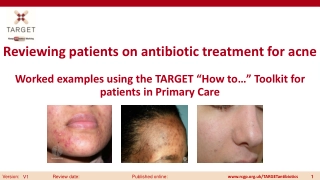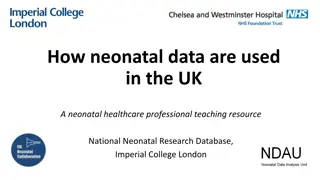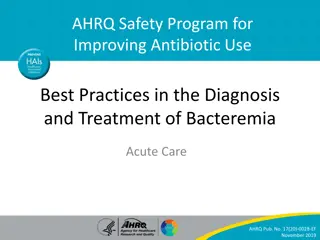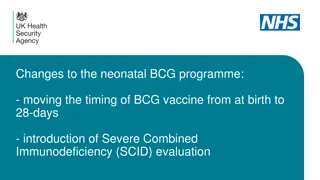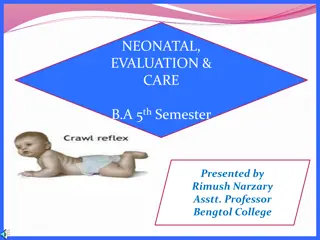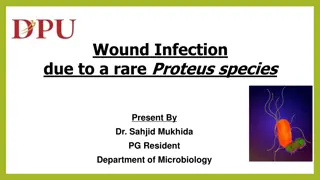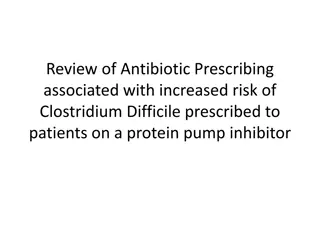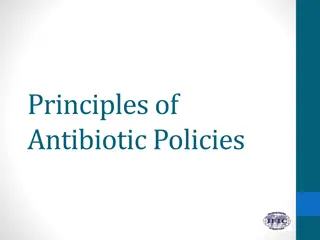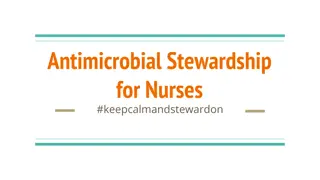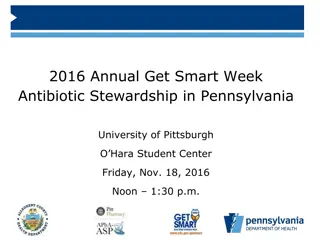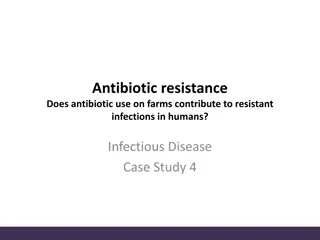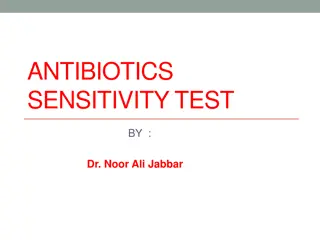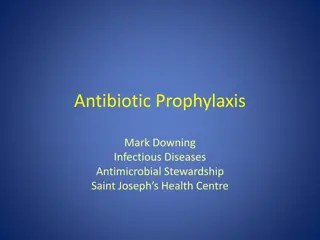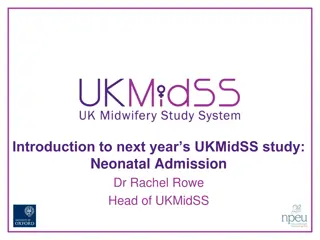Rare Case of Neonatal Meningitis with Antibiotic Challenge
A term male baby born with perinatal hypoxia developed neonatal meningitis with convulsions. Blood culture revealed Acinetobacter sp. and Pseudomonas sp. Empirical antibiotic therapy was escalated to Colistin and Ceftazidime due to resistance. Subsequent testing showed colonies resembling Pseudomonas sp. but with unique characteristics. The treatment challenge continued due to atypical findings.
Download Presentation

Please find below an Image/Link to download the presentation.
The content on the website is provided AS IS for your information and personal use only. It may not be sold, licensed, or shared on other websites without obtaining consent from the author. Download presentation by click this link. If you encounter any issues during the download, it is possible that the publisher has removed the file from their server.
E N D
Presentation Transcript
A Rare case of neonatal A Rare case of neonatal Meningitis Meningitis Department of Microbiology Presenter: Dr Sriram K Junior Resident
History of present illness A term male baby weighing 3kg, was delivered by normal vaginal delivery (on 16/11/20). Baby didn t cry even after vigorous stimulation and was intubated and shifted to NICU in view of Perinatal Hypoxia. Provisional diagnosis of Perinatal Hypoxia with Stage II Neonatal Encephalopathy was made. Also baby was having bouts of convulsions for which he was put on anticonvulsant therapy. O/E- HR- 146/min, RR- 70/min, BSL- 128mg/dL
As a part of NICU protocol and in view of increasing WBC count (24,100/ L), Blood culture was sent to Department of Microbiology. Patient was intubated. ET secretions were also sent for culture and sensitivity. Empirically patient was started on Amoxycillin+Clavulinic acid (75mg/Kg/day) BD and Gentamicin(4mg/Kg/day) OD. Acinetobacter sp. was isolated and reported from Blood culture and Pseudomonas sp from ET tube secretion (CFU>105/mL).
Acinetobacter sp reported from blood Pseudomonas sp reported from ET secretions Sensitive Resistant Sensitive Resistant 1. 2. 3. 4. 5. Norfloxacin Amikacin Gentamicin Ceftazidime Ceftazidime+Cl avulinic acid Ceftazidime+Ta zobactam Cotrimoxazole Piperacillin+Taz obactam Meropenem 10. Amoxicillin+Cla vulinic acid 1. 2. 3. Ampicillin Cefoxitin Cefotaxime/Cef triaxone Chloramphenic ol 1. 2. 3. Amikacin Ceftazidime Ceftazidime+Cl avulinic acid Ceftazidime+Ta zobactam Carbenicillin Piperacillin Piperacillin+Taz obactam Colistin Tigecycline Gentamicin Cefoxitin Cefotaxime/Cef triaxone Ciprofloxacin Meropenem Amoxicillin+Cla vulinic acid Fosfomycin Ofloxacin Tobramycin 10. Imipenem 1. 2. 3. 4. 4. 4. 5. 6. 6. 5. 6. 7. 7. 8. 7. 8. 9. 8. 9. 9.
Continue.. Antibiotic escalation was done according to the reports, from Amoxycillin+Clavulinic acid and Gentamicin to higher antibiotics Colistin and Gentamicin as per drug susceptibility report on 19th November 2020. As on 23rd Nov. No major improvement was seen. Blood culture was repeated (as no clinical improvement) and antibiotic escalation was done to Colistin(50,000IU/Kg/day) TDS and Ceftazidime(100mg/Kg/day) TDS. Sample plated on 23rd Nov. report dispatched on 25th Nov. as Gram negative Non-Lactose fermenting organism isolated, resembling Pseudomonas sp. Some Biochemical tests and other supplementary tests were not characteristic of Pseudomonas species.
The colonies were similar to Pseudomonas sp.,in a sense that they were Non lactose fermenting colonies, but unlike the colonies of Pseudomonas sp. they were circular and convex looking, rather than spreading out on the culture plate. It was Non-motile Test for indole and urease positive And it utilized mannitol unlike Pseudomonas spp.
Organism was initially reported as Pseudomonas sp. without delay and later it was processed by Automation (Vitek-2C) for accurate identification and drug susceptibility. Vitek 2C identified the isolate as Elizabethkingia meningoseptica At this moment patient was already on Colistin(50,000IU/Kg/day) and Ceftazidime(100mg/Kg/day). As the baby was not showing any improvements even after treatment with anticonvulsant, to rule out Meningitis a CSF tapping was done and CSF was sent for culture and sensitivity. Same organism Elizabethkingia meningoseptica was identified from CSF too. Direct Microscopy On 4th Dec Linezolid was started
Outcome The baby s guardians were not willing for further treatment in the hospital and hence was discharged against medical advice Patient was hemodynamically stable at the time of discharge but convulsions were still persistent At the time of discharge the baby was put on Syrup Linezolid(10mg/Kg/day) 1.5mL TDS and Tab. Levofloxacin 250mg in 10mL of water of which 1.2mL BD for 15days Patient condition till date: baby alive, no indication of septicaemia
Discussion Discussion Elizabethkingia meningoseptica organism named after the American scientist Elizabeth O King who was studying unclassified bacteria associated with pediatric meningitis at the Centers for Disease Control and Prevention in Atlanta. It is widely distributed in nature (Eg Fresh Water, Soil or Salt Water). Microscopic appearance : Gram Negative slender, slightly curved rod, non spore forming and aerobic organism. Direct Microscopy
Intrinsically Resistant : Aminoglycosides, Tetracycline, chloramphenicol, - lactams, Colistin(ESBL, Carbapenem hydrolyzing MBL producer)(Bhat KS et al)(Principles and practice of infectious diseases edition 9). Organism is reportedly sensitive : quinolones, minocycline, Cotrimoxazole, rifampicin and novobiocin(Bhat KS et al, Ghafur M et al)(Principles of internal medicine edition 19). Also some reports have suggested Sensitivity towards : Vancomycin, Clindamycin, Macrolides(Bhat KS et al)
It is more of an opportunistic infection mostly affecting immunocompromised individuals(Ghafur A et al)known to cause neonatal septicemia and meningitis(Bhat KS et al) Quite often the organism is misidentified as Pseudomonas spp based on the routine biochemical tests employed for identification(Arbune M et al) The organism is known to be resistant to majority of the antibiotics used in treating gram negative bacteria but it was found that it responds well antibiotics used for Gram positive organism(Ghafur A et al, Bhat KS et al)
Source. A Root cause analysis and source analysis was done by Hospital Infection Control team, where Multiple samples were collected from Health care workers and Hi-touch areas of NICU and Labor room too, but, Unfortunately the same organism was not isolated in any of the samples.
TAKE HOME MESSAGE Elizabethkingia meningoseptica is an emerging nosocomial infection(Arbune M et al) with high risk of complication and mortality especially in neonates. It is often misidentified and hence Early accurate diagnosis by Automation is needed for prompt and effective treatment. Effective Infection control practices in Hospital are necessary to prevent Elizabethkingia meningoseptica epidemics.
References 1. Ghafur A, Vidyalakshmi PR, Priyadarshini K, Easow JM, Raj R, Raja T. Elizabethkingia meningoseptica bacteremia in immunocompromised hosts: The first case series from India. South Asian J Cancer. 2013 Oct;2(4):211-5. doi: 10.4103/2278-330X.119912. PMID: 24455635; PMCID: PMC3889038. 2. Bhat K S, Priya R, Krishnan L, Kanungo R. Elizabethkingia meningoseptica bacteremia in a neonate: A case report and mini-review of the literature. J Curr Res Sci Med 2016;2:42-5 3. Arbune M, Fotea S, Nechita A, Stefanescu V. Emerging Infection with Elizabethkingia Meningoseptica in Neonate. A Case Report. J Crit Care Med (Targu Mures). 2018 Jul 1;4(3):96-100. doi: 10.2478/jccm- 2018-0013. PMID: 30582002; PMCID: PMC6294984. 4. Harrison s Principles of Internal Medicine edition 19 5. Mandell, Douglas and Bennett s Principles and Practice of infectious diseases edition 9
Acknowledgement Department of Paediatrics Dr D Y Patil Medical College Hospital & Research Centre Dr D Y Patil Vidyapeeth


